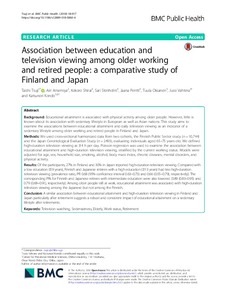Association between education and television viewing among older working and retired people: a comparative study of Finland and Japan
Tsuji T; Amemiya A; Shirai K; Stenholm S; Pentti J; Oksanen T; Vahtera J; Kondo K
Association between education and television viewing among older working and retired people: a comparative study of Finland and Japan
Tsuji T
Amemiya A
Shirai K
Stenholm S
Pentti J
Oksanen T
Vahtera J
Kondo K
BMC
Julkaisun pysyvä osoite on:
https://urn.fi/URN:NBN:fi-fe2021042719777
https://urn.fi/URN:NBN:fi-fe2021042719777
Tiivistelmä
Background: Educational attainment is associated with physical activity among older people. However, little is known about its association with sedentary lifestyle in European as well as Asian nations. This study aims to examine the associations between educational attainment and daily television viewing as an indicator of a sedentary lifestyle among older working and retired people in Finland and Japan.Methods: We used cross-sectional harmonized data from two cohorts, the Finnish Public Sector study (n = 10,744) and the Japan Gerontological Evaluation Study (n = 2493), evaluating individuals aged 65-75 years old. We defined high-duration television viewing as >= 4 h per day. Poisson regression was used to examine the association between educational attainment and high-duration television viewing, stratified by the current working status. Models were adjusted for age, sex, household size, smoking, alcohol, body mass index, chronic diseases, mental disorders, and physical activity.Results: Of the participants, 27% in Finland and 30% in Japan reported high-duration television viewing. Compared with a low education (<= 9 years), Finnish and Japanese retirees with a high education (>= 13 years) had less high-duration television viewing [prevalence ratio, PR 0.68 (95% confidence interval 0.63-0.73) and 0.66 (0.55-0.79), respectively]. The corresponding PRs for Finnish and Japanese retirees with intermediate education were also lowered [0.89 (0.83-0.95) and 0.79 (0.68-0.91), respectively]. Among older people still at work, educational attainment was associated with high-duration television viewing among the Japanese but not among the Finnish.Conclusion: A similar association between educational attainment and high-duration television viewing in Finland and Japan particularly after retirement suggests a robust and consistent impact of educational attainment on a sedentary lifestyle after retirements.
Kokoelmat
- Rinnakkaistallenteet [27094]
